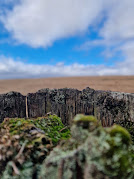Lesson 5: Out of this world and into the classroom.
Out of this world and into the classroom.
By Stacey Salt inspired by an out of this world experience with Matthew Salt and Tenby at Marsden Moor
 |
| The view from the top of the moor |
 |
| The view from the top of the moor |
 |
| The bridge running through the moor |
 |
| A world within a world |
The feelings I have felt, surrounded by nature, being present, breathing, noticing are calmness, fulfilment, happiness, joy, belonging, and I can only have these feelings if I respect the surroundings, if there is a sense of trust and kindness within the experience. When we dig deep into foundational factors of an out of this world experience, can we feel out of this world in other places too? This leads me to consider the classroom as an out of this world experience. What would that look and feel like? If we take the definition I proposed above intertwined with the values and feelings I felt we can certainly begin to imagine somewhere students would flourish, equity is fostered and the simplicity of an experience can engage with students and teachers into the teaching and learning journey.
Out of this world: being present in an experience physically, emotionally, spiritually and mentally, which embodies you and ignites curiosity into something bigger than what you knew but you will feel innately.
If we think of a classroom, an out of this world experience that involves both teacher and student, power relations are taken down. In Teaching to Transgress, bell hooks talks about holistic models of learning, classrooms which empower both teachers and students. So what can students learn from us, and what can we learn from students, in its simplest format that builds on the out of this world concept?
If I think back to my walk at Marsden Moor, what was around me? What was making me think deeply? What was making me feel like I belonged? The answer is, something that was already there, it wasn’t anything new, I was drawing upon what already existed to create a new feeling, new learning, the interactive processes which sparked my senses to be curious and naturally want to acquire new information which in turn developed my human functioning. In the classroom environment this could look like storytelling, a film with discussion. It could be a walk around the campus, a change of physical space but ultimately it needs to be something inclusive, even if not directly related to the subject, lessons can still be learnt. Out of this world lessons, in my opinion, require vulnerability and trust in the space, to truly empower one another (teacher and student)...it is about everyone embracing an out of this world experience to be true to themselves and to each other. It is about connection to something you never knew but will feel. The logs that welcomed a world within a world, the rocks that held up others and the road which carried on into the unknown. We came out differently, we came out empowered, we discussed it, I wrote it, Matt read it and curiosity became something much bigger, it was out of this world!
“Professors who embrace the challenge of self-actualisation will be better able to create pedagogical practices that engage students, providing them with ways of knowing that enhance their capacity to live fully and deeply” (hooks, 1994)
Thinking point
- If the concept of an 'out of this world' classroom meant stepping outside of the status quo of education, what would this look and feel like?
References human and non-human
Matthew Salt, husband and fellow adventurer, inspired by our discussion at Mardsen Moor
bell hooks (1994), Teaching to Transgress: Education as the Practice of Freedom , Abingdon: Routeledge.
Tenby, my non-human companion, running around Marsden Moor like it is out of this world.

The rocks, water, bridge, road to out of this world and world withing a world, appreciation to Marsden Moor and the non-humans for giving me life, inspiration and connection, 2023.




Comments
Post a Comment